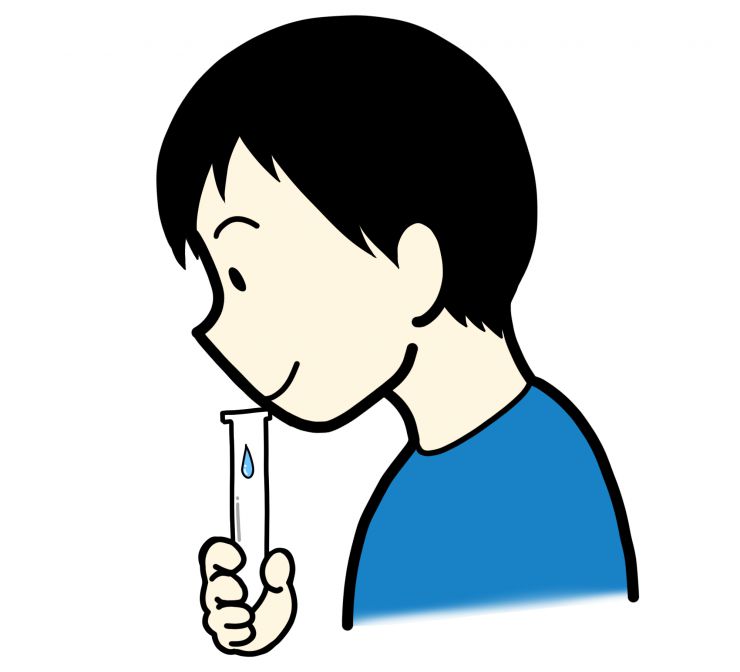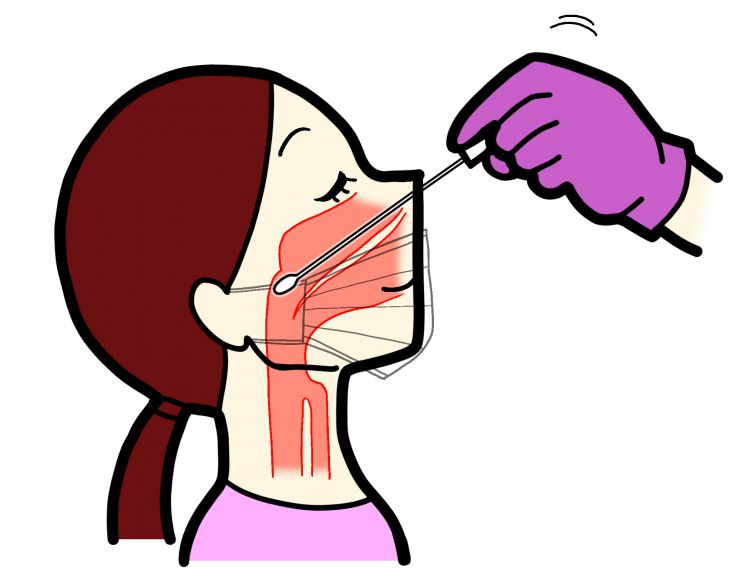Inspevtion methods
At our hospital, both saliva and nasopharyngeal wipes can be tested.
・PCR test with saliva
Under the control of medical staff, it is considered to be a sample with a low risk of spreading infection to the surroundings because it can be collected by the patient himself and it does not emit droplets at the time of collection. The detection sensitivity is considered to be similar to that of nasopharyngeal swab, and it has the advantage of not being affected by the skill of the person who collects the sample.
To collect saliva, the subject collects 1 to 2 mL of saliva, which naturally and gradually flows out, in a sterilization tube. Those who do not produce saliva due to dehydration etc. are expected to have lower detection sensitivity. Also, eating, drinking, brushing teeth, and collecting saliva immediately after gargling can affect virus detection and should be avoided. There is no clear standard set by the government, but as a guide,it is desirable to wait at least 10 minutes, preferably 30 minutes, before taking a saliva test, after eating or drinking, or after brushing your teeth.
Since the outside of the collection container may be contaminated when saliva is collected by the subject himself, we collect it safely in a disposable container.

・PCR test with nasopharyngeal Swab
Since SARS-CoV-2 (official name of the new coronavirus) is transmitted from the upper respiratory tract such as the nose and mouth, the most standard and reliable sample is a nasopharyngeal swipe at the beginning of infection.
Many university hospitals and public hospitals basically perform nasopharyngeal wipes. In other countries, saliva tests are not recognized as formal tests, and in some countries, only nasopharyngeal wipes are formal tests.Unlike the saliva test, the nasopharyngeal wipe test has almost no effect on the test results even if you eat or drink, brush your teeth, or gargle until just before.
At this hospital,a skilled doctor working at a public hospitaldirectly conducts a nasopharyngeal wipe test.

・ Difference between PCR test by saliva and PCR test by nasopharyngeal wipe
There is a research result that the probability that the test result of patients who are not infected with the COVID-19 is correctly negative = (specificity) is 99.9% or more for both the saliva test and the nasopharyngeal wipe test. In other words, it can be said that the one with a low probability of being infected with the new coronavirus is suitable as a test to be taken just in case.
However, there is a difference in the probability that the test results of patients infected with the new coronavirus will be positive correctly(sensitivity), and the PCR test with a nasopharyngeal wipe reveals that the infection is more correct. Therefore, at university hospitals and public hospitals, those who may have been infected with the new coronavirus and those who have been in close contact with infected people are basically tested with a nasopharyngeal wipe. At our hospital, we basically recommend a nasopharyngeal wipe for patients who are likely to be infected with the new coronavirus.
Responsibility: Director Yuki Kakehashi
References: Guidelines for pathogen testing for new coronavirus infection (COVID-19), 1st edition, guidelines for pathogen testing, 1st edition, National Institute of Infectious Diseases, National International Medical Research Center, National Health Center Directors' Association, Local Health Research Institute National Council, Japanese Society Japanese Society for Infection Control and Prevention, Japanese Society for Clinical Hygiene Inspection Engineers, Japanese Society for Clinical Microbiology, Ministry of Health, Labor and Welfare, Health Bureau, Tuberculosis Infectious Diseases Division



